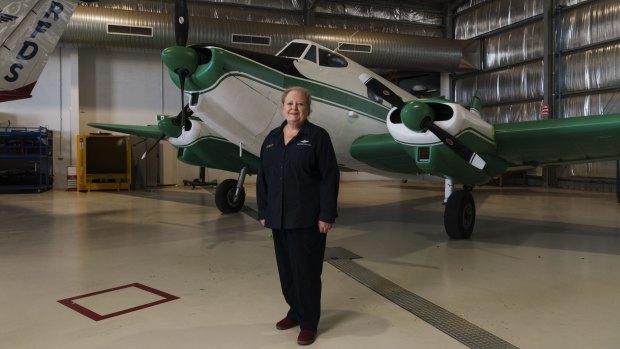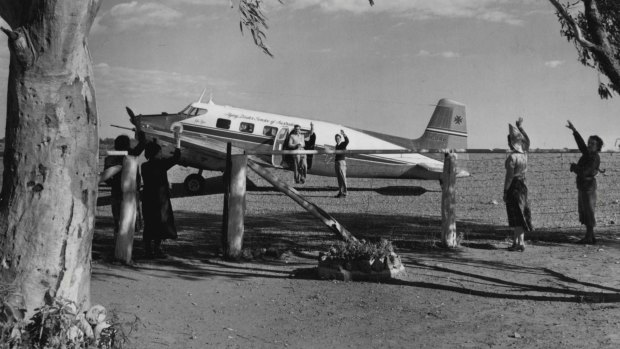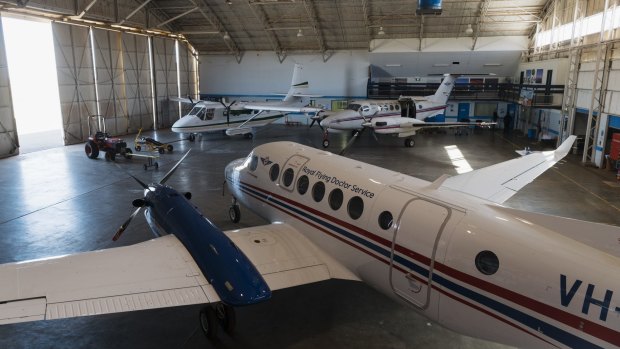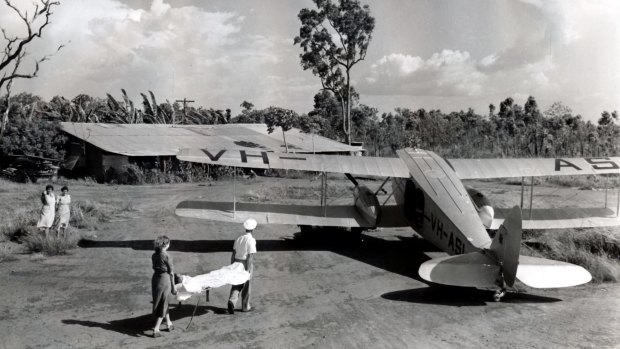This was published 3 years ago
Broken Hill, NSW: The great missing Royal Flying Doctor plane search
By Anthony Dennis

Sue Williams, from the Royal Flying Doctor Service Broken Hill visitor experience, with the service's first single-wing, three engine aircraft from the 1950s, on permanent loan from the Powerhouse Museum.Credit: James Brickwood
Inside an ancient hangar at its Broken Hill base, the Royal Flying Doctor Service has painstakingly, a propeller here and a fuselage there, been reviving its nearly century-long past with the latest piece in the aeronautical jigsaw now in plane sight.
It's a gleaming, freshly repainted, three-prop de Havilland Australia DHA-3 Drover, the first mono-wing aircraft operated by the RFDS in Broken Hill in the 1950s and 1960s that was discovered in the collection of the Powerhouse Museum in Sydney.
It took a year of negotiations for the aircraft, which replaced the service's previous antiquated Dragon bi-plane from the 1930s, to be finally granted to the RFDS on a permanent loan basis.

A Flying Doctor plane leaving a homestead after a medical visit.Credit: Fairfax Media
"This project is a great opportunity to reflect on where we have come from aeronautically," says John Larkin, the Royal Flying Doctor Service's head of tourism, "and how we have been able to continually improve the service with every new aircraft that has gone into service."
Nowadays, with nearly 80 modern aircraft in its fleet, including jets, there are often as many Royal Flying Doctor aircraft in Australian airspace, as evidenced by live"flight radar" sites, than there are for the pandemic-hit national carrier.
It's certainly a far cry from the first RFDS medical retrieval flight that took off on May 17, 1928, from Cloncurry, Queensland, aboard a de Havilland DH 50 single engine biplane.

Part of the museum collection is a handful of old RFDS planes, including a Nomad N22C.Credit: James Brickwood
It was the fruition of the dream of the founder of the RFDS, the Very Reverend John Flynn to bring a "mantle of safety" to those living, working and travelling Australia's unforgiving interior.
Outback medicine, of course, remains the noble modus operandi of the service, a charity which attends to the health needs of 8 million people in regional Australia. But tourism is evolving as an important means of conveying the RFDS message as well as a way to generate revenue and donations.
The Drover, along with other planes, including a former Australian Army Nomad and an original B200 Beechcraft retired from the RFDS, will form the basis of its historic medical aircraft fleet. Both the Drover and the Nomad had to be dismantled and trucked by semi-trailers to Broken Hill for reassembly

Royal Flying Doctor Service patient retrieval in 1957.Credit: Fairfax Photographic
Sue Williams, the tourism manager at the service's RFDS visitor experience at Broken Hill, about 1200 kilometres west of Sydney, says that the trio of aircraft will go on display to the public as early as November.
"Once funding support is achieved, the RFDS has a long-term goal to bring back to life the McCardell hangar [which dates to 1938] to house a full complement of historic aircraft," she says. "It would be a privilege for RFDS to display aircraft that once flew from Broken Hill's 84 year-old base.
"These aircraft - some of them made of wood and canvas - once flew life-saving aero-medical missions retrieving sick or injured patients living or travelling in remote, rural and regional communities surrounding Broken Hill."
Mr Larkin says that the best moment so far during the project has been standing in front of the completed aircraft, covered in dust and paint, and reflecting on "the giant aircraft jigsaw puzzle" the RFDS has embarked on.
But the denouement to this detective story is yet to be penned. To complete the collection, a DH-83 Fox Moth which flew between 1937 and 1939, a DH-84 Dragon, which operated from 1942 until 1953 and a Beagle B206S that served from 1967 until 1978, will need to be acquired, with the latter aircraft known to be in the UK.
The RFDS flight radar map (link here) shows, in real-time, their planes in the air, providing vital aero-medical services to country Australia.
Traveller editor Anthony Dennis and photographer James Brickwood travelled courtesy of Destination NSW, see visitnsw.com
Sign up for the Traveller Deals newsletter
Get exclusive travel deals delivered straight to your inbox. Sign up now.